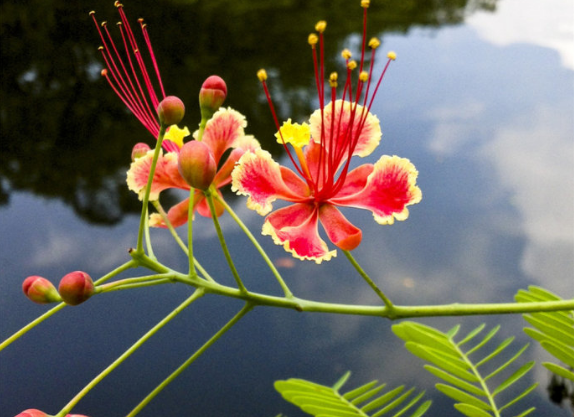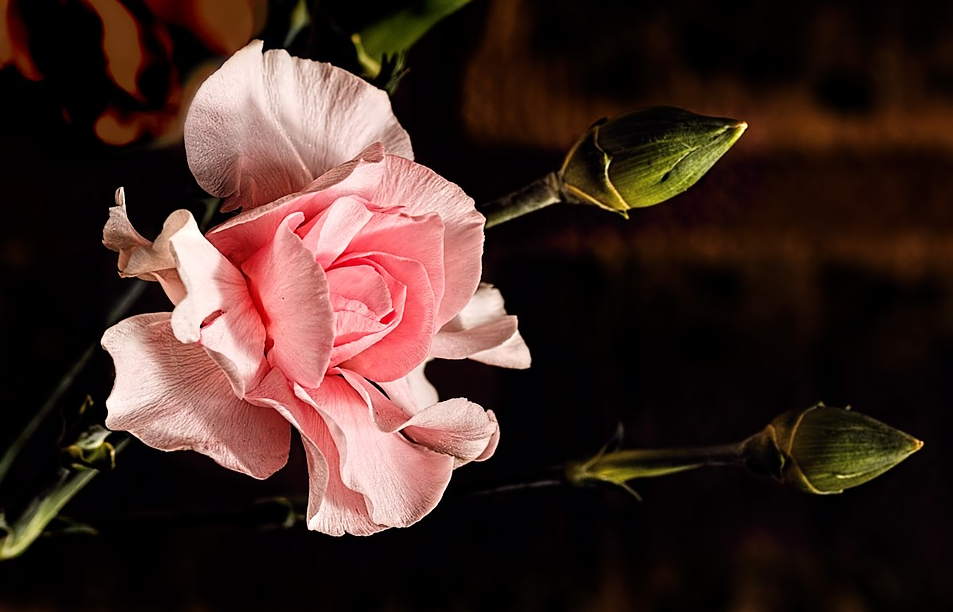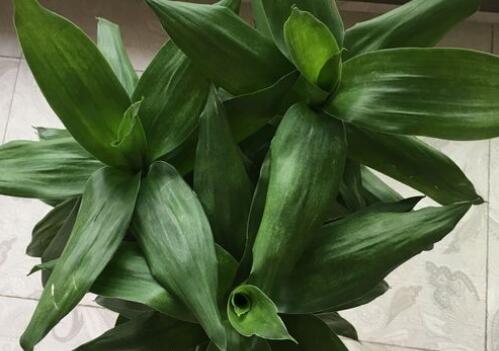How to raise buttercups at home? What is the effect and function of buttercup? (with pot maintenance skills of Jinfeng flowers)
Goldilocks is native to the West Indies and is cultivated in Yunnan, Guangxi, Guangdong and Taiwan. It is one of the valuable ornamental trees in the tropics. So how do you keep buttercups at home? What is the effect and function of buttercup? What are the pot maintenance skills of buttercup?

I. the basic introduction of Goldilocks
1. Morphological characteristics
Goldilocks are large shrubs or small trees, up to 3 meters high: branches green or pink, with sparse spines. Bipinnately compound leaves 4 to 8 pairs, opposite, leaflets 7 to 11 pairs, long elliptic or Obovate, base askew, J tip notched, petiolule very short. Racemes terminal or gelatinous, flowers orbicular stipitate, orange or yellow, pedicels to 7 cm long. Yingguo black. There are 6 to 9 seeds. The flowering and fruiting period is almost all year round.
two。 Growth habits and distribution
Buttercup is a hot buttercup species, like high temperature and high humidity climate environment, low plug resistance, in case of long-term low temperature of 5 ℃, branches suffer cold injury, avoid frost, South China's Guangzhou, Nanning and other places, normal years can be safe to winter in the open field.
Potted golden wind flower, moved into the greenhouse or indoor in winter, the room temperature should not be less than 10 °, like light, not resistant to shade, strong sun and high temperature, should be planted in the place with sufficient sunshine, and should not be harsh on soil, sandy soil or clayey soil is suitable, acid-loving soil, more drought-resistant, but also slightly water-resistant.
It is native to the West Indies and is cultivated in Yunnan, Guangxi, Guangdong and Taiwan. It is one of the valuable ornamental trees in the tropics.
3. Reproduction method
Goldilocks are mostly propagated by seeds. From mid-June to mid-December, British fruits become mature one after another. From September to October, the mature fruits are collected and exposed to the sun. After cracking, the seeds can be sown as they are picked, and the seedlings can survive the winter against cold. The seeds can also be stored for spring sowing in the following year. The seed germination temperature should be above 20 °. It is suitable to sow the seeds in the middle and late March of spring. Soak the seeds in 60 °warm water before sowing, soak the seeds for 12 hours after sowing, germinate quickly, begin to germinate three days after sowing, germinate within a week, and the germination rate is about 60brf.
In addition, the method of strip sowing is used, the growth rate of seedlings is medium, and nitrogen fertilizer is applied at seedling stage for 3 times. After October, nitrogen fertilizer is stopped and potassium fertilizer is applied consistently to promote early Lignification, pay attention to cover frost prevention in winter, 1-year-old seedlings can be planted in nursery, 2-year-old young trees can blossom for viewing. If leaf spot occurs, it can be controlled with 50bf} carbendazim wettable powder.
Second, the efficacy and function of buttercup.
1. Ornamental value
Goldilocks, Leguminosae, is an erect evergreen shrub. Up to 3 meters high, the Corolla is orange-red, the edge is golden, and it blooms on the branches all the year round like a flame butterfly. It is one of the valuable ornamental trees in the hot area.
Among the flowers, buttercups are not attracted by their color and fragrance, but mainly by their appearance. Goldilocks flower shape is particularly strange, the flower is like a flying Phoenix, the flower has a head and tail, wings and feet, vivid image, vivid, just like a Phoenix flying, people have to admire the magic and wonder of nature.
two。 Medicinal value
Goldilocks is a famous traditional Chinese medicine, which has the effect of promoting blood circulation and dredging menstruation. Stem juice is taken with yellow rice wine, which can be used to treat injuries caused by falls.
Goldilocks seed also known as hasty, stem also known as through bone grass, can be used in medicine, has the effect of promoting blood circulation, diuresis and detoxification, passing through the bone. Fresh grass smashed outside, can treat sores, furuncle swelling and pain, poisonous insect injury. Seed is an antidote, which can relieve menstruation, induce labor, dispel cool and eliminate accumulated blocks, which should not be taken by pregnant women; whole grass juice is used externally to treat injury. Seeds contain saponins, fatty oils, perylene alcohol, polysaccharides, proteins, amino acids and volatile oils. China's northern and southern provinces have cutting cultivation: for viewing, in addition to flower borders and bonsai devices, it can also be used as cut flowers.
Flowers can be used in medicine to promote blood circulation and reduce distension, and to treat convulsions and injuries. External application of flowers can cure goose palm madness. It can also remove body odor; external application of seed ointment can cure numbness and soreness. Activating blood circulation and dredging menstruation, dispelling wind and relieving pain, external use and detoxification. For amenorrhea, fall injury, blood stasis, swelling and pain, rheumatoid arthritis, carbuncle furuncle treatment of sores, snake bites, hand pain. Modern pharmacological studies have found that buttercup also contains a variety of anthocyanins, which has varying degrees of inhibitory effect on various pathogenic bacteria, such as Xanthomonas, Pseudomonas aeruginosa, Shigella and so on.
In addition, buttercup petals are commonly used in Chinese folk to treat gray fingernails.
Third, the maintenance skills of buttercup pot cultivation.
1. The soil is suitable
The medium for the cultivation of buttercup is better in the fertile and loose sandy soil, and the soil needs to be slightly acidic, which is more conducive to the growth of buttercup. If the acidity is not enough, an appropriate amount of ferrous sulfate solution can be added to the water when watering.
two。 Appropriate watering
Goldilocks are more drought-tolerant and do not have high requirements for moisture. In the peak growth period and full flowering period, we need more watering to keep the pot soil moist and have enough water to grow and blossom normally. In spring and autumn, it can be watered 2-3 times a week; when the temperature is high in summer, it can be watered once a day; in winter, the basin soil can be slightly moist and watered once a week.
3. Suitable light
Buttercup is a light-loving plant, the more sufficient light to grow, the better, it can be kept in full sunlight. If the light is insufficient or shaded for a long time, the branches and leaves of buttercups will grow, the leaves will be dull, and even will not blossom.
4. Control the temperature
Buttercup is a tropical plant, likes to grow in a high temperature environment, but its cold tolerance is very weak, it is not suitable to be planted in the north. In winter, it is necessary to keep the growth environment of buttercups not less than 10 degrees, otherwise it will seriously affect the growth and lead to frost injury.
5. adequate manuring
During the growth of buttercup, thin nitrogen fertilizer can be applied to it every half a month, which can promote the growth of branches and leaves. However, before flowering, it is necessary to apply phosphorus and potassium fertilizer and reduce the amount of nitrogen fertilizer, which can promote flower bud differentiation and increase the quantity and quality of flowering.
IV. Breeding methods of Goldilocks
1. Sowing and reproduction
The most suitable time for sowing is from September to October, when the temperature and humidity are satisfied with the germination and growth of buttercup seeds. Put the seeds in warm hot water for 12-24 hours, let the seeds absorb water and expand, then sow the seeds on the seedbed, then cover the soil with a thickness of about 1 cm, and then use the soaking basin method to water it, as long as the environment is suitable, it usually takes less than two weeks to take root and sprout.
two。 Cuttage propagation
The sturdy branches were selected as cuttings on the buttercup plant, and three nodes should be retained on the cuttings. after the branches were treated, they were inserted into the appropriate soil, then watered and sterilized with chlorothalonil solution. As long as the maintenance is good, it is usually enough to take root in 10-14 days.
3. Common diseases and insect pests
(1) spot disease
After buttercup is infected with spot disease, there will be some small spots on the leaves, then gradually expand and become larger, and the infection of other leaves will slowly spread to the plant. After the disease is found, the diseased leaves and fallen leaves should be cleaned up in time, and then sprayed with mancozeb.
(2) nematodes
Nematodes mainly erode the roots of buttercups, causing the roots to grow nodules, causing the plants to grow slowly, gradually weaken and wither. After the discovery, the plants should be removed from the basin soil in time, and the soil should be disinfected and dried to eliminate the eggs in the soil.
Time: 2019-04-06 Click:
- Prev

Are carnations poisonous? How to raise carnations at home? Can I eat it?
Carnation is known as carnation, also known as lion carnation, carnation, Dutch carnation, etc., Carnation family, carnation plants, deeply loved by people, so carnations poisonous? How to raise carnations at home? Can I eat it? Are carnations poisonous? carnations are non-toxic. You don't have to worry about that.
- Next

How can rich bamboo take root? How many are the luckiest to keep at home?
Now people living in cities have no land to grow flowers and plants, they use all kinds of pots and vases to raise all kinds of green plants, some are hydroponically cultivated and some are cultivated in soil, and there are two planting methods called Fugui bamboo. How to raise the rich bamboo to take root? It is the most auspicious to put a few at home.
Related
- Fuxing push coffee new agricultural production and marketing class: lack of small-scale processing plants
- Jujube rice field leisure farm deep ploughing Yilan for five years to create a space for organic food and play
- Nongyu Farm-A trial of organic papaya for brave women with advanced technology
- Four points for attention in the prevention and control of diseases and insect pests of edible fungi
- How to add nutrient solution to Edible Fungi
- Is there any good way to control edible fungus mites?
- Open Inoculation Technology of Edible Fungi
- Is there any clever way to use fertilizer for edible fungus in winter?
- What agents are used to kill the pathogens of edible fungi in the mushroom shed?
- Rapid drying of Edible Fungi

